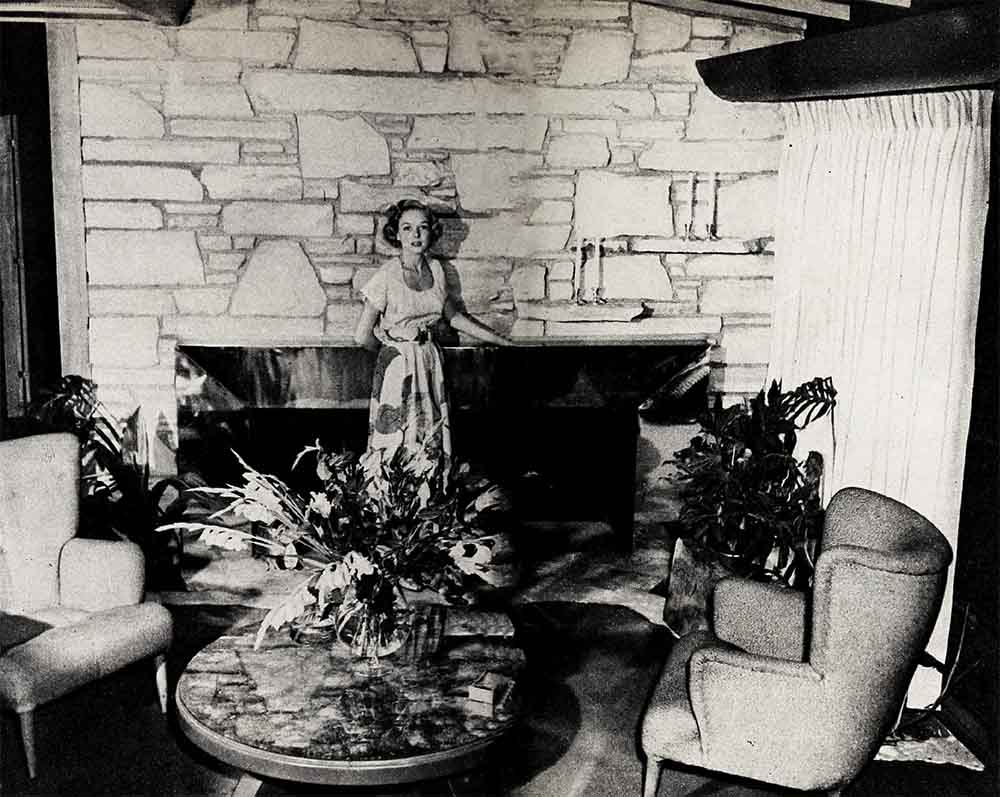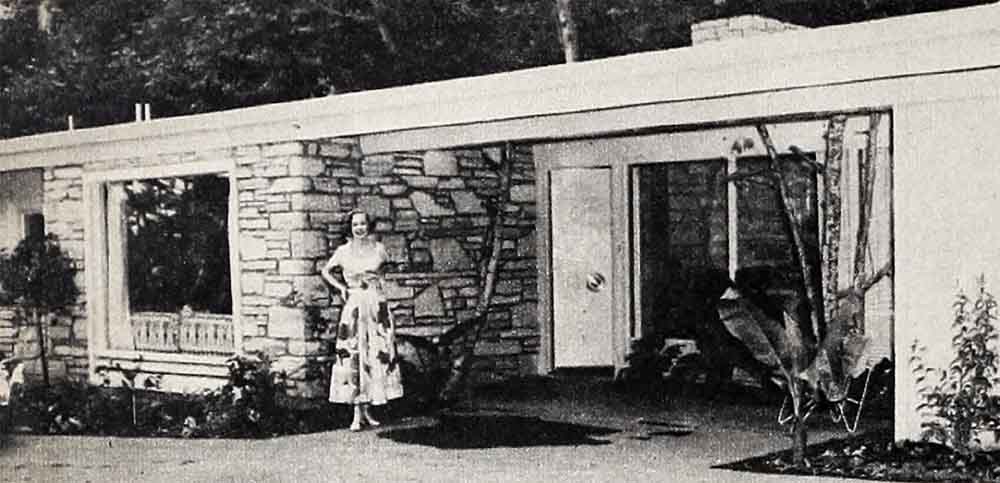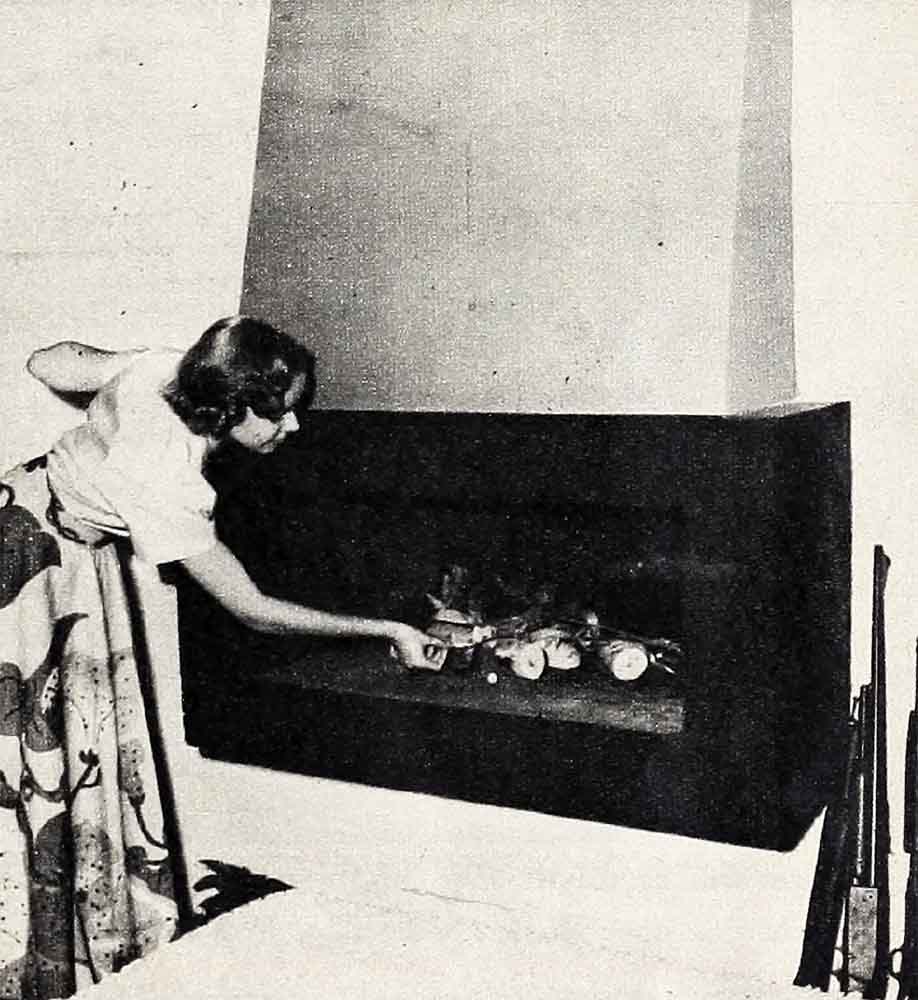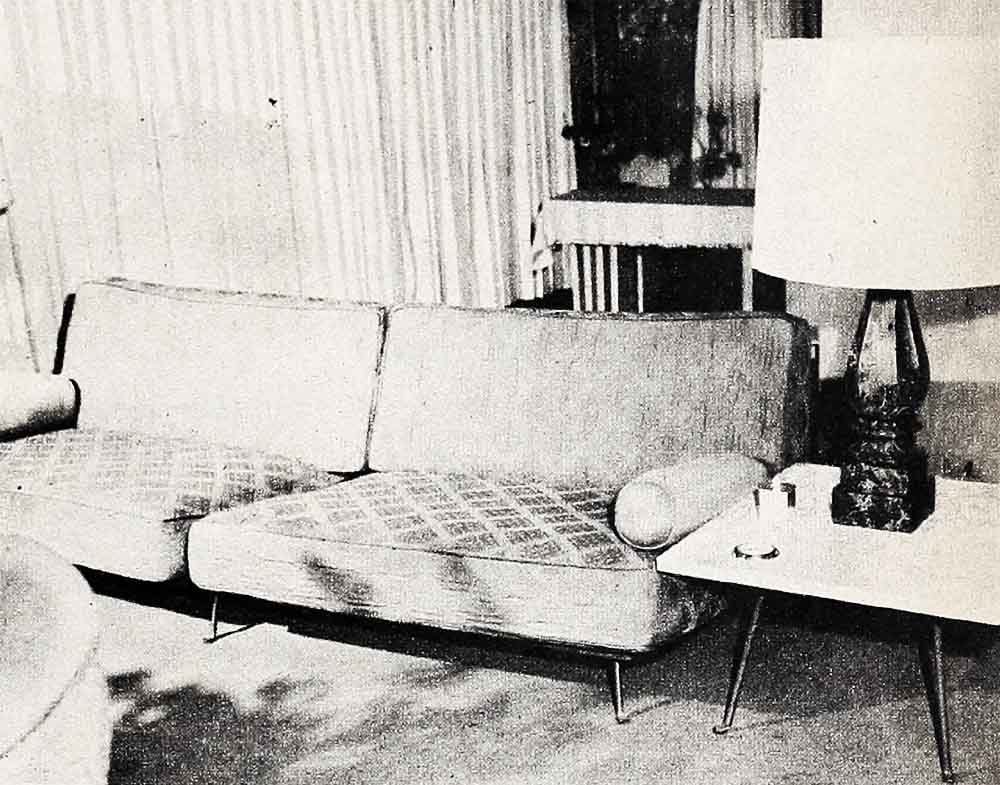The Low Cost of Happiness
As a perfect example of the perfect small house for any young pair of honeymooners, I give you the gay residence of Diana Lynn and John Lindsay. Never, I believe, have I ever seen a small house that more ideally embodied the right principles for young people, who want to live in comfort and charm, but who must achieve a smart result without much money to spend in the first place.
Youth should be a time of gaiety. A honeymoon house, certainly, should reflect happiness, not too much responsibility, and nothing “stuffy.” Tradition comes later—seriousness, perhaps, with the arrival of one’s children.

Exactly this is the atmosphere that the newlywed Mr. and Mrs. Lindsay have made their house reflect, and they have done it all, from kitchen to large living room, dining room and through their three bedrooms and two baths, for the unbelievable sum of $2,500 overall. They had nothing “to start with” from John’s bachelor or Diana’s glamour girl days save one coffee table.
There are no glaring “empty” spots in their trig modern house, which John, the architect, designed. Their hangings are up in every room. All their floors are covered. Their chairs are very comfortable. Their lamps are adjusted to reading. Yet, even allowing for the better than $500 they “buried” in the kitchen, as Diana says, in necessary refrigerator, gas stove and the like, they have no tacky makeshifts spotted here and there.

So, how did they manage a large living-dining room, three bedrooms and two baths complete for less than $2000, in a day when the most ordinary living room couches cost a minimum of $150; when hangings for one single room often run to a hundred dollars or more; when average lamps cost twenty-five dollars each. How did the young Lindsays achieve beds, with bedside tables, curtains for a vast expanse of windows, floor coverings, even lighting fixtures for their walls at such a sum?
To begin with, they had an overall master plan, not only of furnishings but of color schemes. In their bedroom, they used a color scheme of soft pink, with accents of a gray-brown. In their living room, the predominating color is a soft gray-green. Throughout the whole house, their hangings are made of unbleached sailcloth. Sailcloth requires no lining. It hangs in deep pleats that do not “get out.”

With the curtaining problem solved, they faced the carpeting one, which, as you know, can cost you anywhere from $100 to $1000 a room, depending upon the size of your rooms and how much your tariff will bear. Diana and John put down white cotton shag carpeting in their room for about $125. But their real smartness was revealed in their other rooms. From baseboard to baseboard in their living room, in John’s studio, which can serve as a guest room when needed, and in their third bedroom, which currently is not only a workroom for Diana’s secretary, but also an enlarged closet space for Diana’s wardrobe, they put down the underlining for carpets. This has various trade names. Until a couple of years ago, it came only in an intense brown. Since the war, it has come dyed in various colors. The Lindsays chose a soft green shade. This lining for real carpets is completely inoffensive to the eye. Actually, it can be used as is for a short time. What Diana and John plan to do is to use it for its real purpose, as an underpadding for their carpets, when they can afford real carpets.
Architecturally, John left the corners of the living room and his workroom-bedroom unfloored. The earth, thus exposed, is planted in the living room, in this case, with Monstera—-that fast-growing, dramatic plant of the Philodendron family.
Young people do not have the price of tapestries, of bric-a-brac or objets d’art. But these green and growing things, which initially cost only a few dollars, give attention value to what might otherwise be vacant corners.

In John’s workroom, note the wall with the raised fireplace. Actually, this fireplace is on the back wall from the living room fireplace, both of them working off the same chimney. Where the living room fireplace was designed by John to be dramatic, to hold your attention, and at the same time to demand very little upkeep, the bedroom-workroom fireplace was made small, and high off the floor for exactly opposite reasons. This fireplace, having no other “mantel” than that of cement, painted black, is small but capable of giving off great warmth. Yet it not only is modern in concept, but also young. I like it very much. The whitewashed brick wall behind it, however, could look a little cheerless except for the Lindsays putting in that planting of ivy at its base. Give them another year and the ivy will grow over that whitewashed wall. I’m sure John won’t permit it to grow over his numerous guns. Diana assures me John will allow nothing to go near his jumbled work table in this same room. The simple mattress on legs, in this room, with its simple candle- wick bedspread is ready for any casual overnight guest, if need be, or during the day for John when he wants to relax for a brief moment. But, once more, looking forward to a more opulent future, such a mattress-bed, can go into a someday expensive house very neatly.

In their personal bedroom, Diana and John used the same mattress-on-legs idea, thus saving the price of a headboard The tailored ruffle under the bedspread is of sailcloth, like the window hangings, but where the hangings are of the unbleached sailcloth, the bedstead ruffle is dyed a gray-brown to match the tailored pillows that serve as a daytime headboard. Over this is a very tailored sailcloth spread dyed a soft pink.
The distinctive touch in this room, however, which can be pointed out to other honeymooning homemakers are, first, the bedside tables, which the Lindsays have duplicated in their living room. Next, note the wall sconces, a variation of which they have also used in the living room.
Look at these bedside tables, then look at the couch side tables in the living room. These are mere stout metal legs upon which flat slabs of marble have been mounted. In Diana’s and John’s case, the marble is of a yellowish cast. You might prefer yours in a whiter or pinker marble, or you might want to use this same design and use mirrors as tops, which would be cheaper. The principle, in either case, is the same, the tables have low initial cost. They are very usable. Drinks and ashes spilled on them can’t hurt them. Dust is easily removed from them. They will not nick, or get cheap-looking as time passes.
When it came to wall fixtures, Diana and John found out exactly what you know, if you have tried to buy any lately. The most trite fixture can cost you anywhere from ten to a hundred dollars. Anything original costs too much. The Lindsays got around this by using candles.
On the combed wood wall of their bedroom, and this combed wood is at once new, inexpensive and effective, and you can order it of any builder, Diana and John placed simple plaster candle holders painted to match the wall. Diana admits they do not light the tapers every night, any more than you light side sconces every night. But they are there when needed. They add charm, and save money while reflecting thoughtful originality.
In the living room, low individual candle holders were used on tiny shelves set into the cut-stone facing above the fireplace.
Let me interrupt myself long enough to say that I like this use of real stone inside a young modem house. Such stone mellows beautifully, which is exactly what can not be said of plaster or painted rooms. In this particular household, the stone wall goes delightfully with the beamed ceilings and the projections that hide, yet dramatize, the top-concealed lighting.
John Lindsay designed his generous living room fireplace for its dramatic emphasis, as well as its usefulness but Diana was the practical one who had the brass hood waxed, so that it wouldn’t eternally have to be polished.
Before the fireplace are two barrel chairs covered in green. They are comfortable, without being fussy with cushions, and are beside the coffee table that survived from John’s bachelor establishment.
Where the smartness of these two young people most shows itself, however, is in that necessary “living room couch.” Any average eight-foot couch costs several hundred dollars. Diana and John solved this problem for less than a hundred. First they had a stout metal frame designed, with a very low back, four short legs and a sturdy cross section.
For seat cushions, they got two children’s-size mattresses. These, they had covered in green fabric to match their barrel chairs. They got two similar mattresses to make the back of the couch. Those had to be padded in extra width at the bottom, narrowed slightly at the top, for comfort in sitting. Padded side arms for either end of the couch were a separate job, but still the price came neatly within a hundred dollars. What’s more, the mattresses later can be remade to fit any size bed, if the time ever comes when the Lindsays want to replace this casual couch with a more important one.
You, too, can use such ingenuity in furnishing your new home.
Just remember, charm is never pretentious. And frank simplicity is delightful when, as with the Lindsays, it is a modern improvised taste, suited to one’s environment, pocketbook and immediate needs.
So you follow your own good judgment—aided a bit, I hope, by what I’ve just told you.
THE END
It is a quote. PHOTOPLAY MAGAZINE JANUARY 1950




